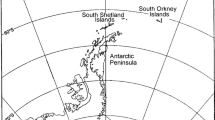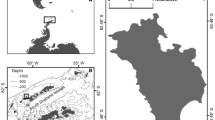Abstract
This study quantifies the manner in which Australian fur seals, Arctocephalus pusillus doriferus, use their prey in a spatial and temporal context. We analysed 977 scat and 66 regurgitate samples collected from Tasmanian breeding colonies and haul-outs between 1994 and 2000. Diagnostic prey remains identified in the scats represented 35 fish taxa and 8 cephalopod taxa. The main taxa identified in scats, where frequency of occurrence was ≥10%, were leatherjacket species (family Monocanthidae), redbait (Emmelichthys nitidus), barracouta (Thyrsites atun), jack mackerel (Trachurus declivis) and red cod (Pseudophysis bachus). Regurgitates were dominated by cephalopods, primarily Gould’s squid (Nototodarus gouldi), Octopus maorum, O. berrima/pallidus and Sepia apama. Discriminant function analyses indicated that there were generally no significant differences in the composition of the diet between colonies within a year, suggesting that prey distribution is fairly uniform throughout Bass Strait at those time scales. The diet at breeding colonies, however, exhibited significant inter- and intra-annual variation, determined by the presence of several key taxa, such as barracouta and a species of scorpionfish (family Scorpaenidae). The diet composition also varied regionally, between Bass Strait and southern Tasmania in spring 1999 and autumn 2000, with redbait, barracouta and a species of scorpionfish identified as the main taxa contributing to this difference. Redbait occurred in the diet only in southern Tasmania, whereas barracouta and scorpionfish occurred only in Bass Strait.

Similar content being viewed by others
References
Arnould JPY, Hindell MA (2001) Dive behaviour, foraging locations, and maternal attendance patterns of Australian fur seals (Arctocephalus pusillus doriferus). Can J Zool 79:1–14
Arnould JPY, Littnan CL (2000) Pup production and breeding areas of Australian fur seals Arctocephalus pusillus doriferus at Kanowna Island and The Skerries in northeastern Bass Strait. Aust Mammal 22:51–55
Blackburn M (1957) The relation between the food of the Australian barracouta, Thyrsites atun (Euphrasen), and recent fluctuations in the fisheries. Aust J Mar Freshw Res 8:29–54
Brothers N, Pemberton D (1990) Status of Australian and New Zealand fur seals on Maatsuyker Island, southwestern Tasmania. Wildl Res 17:563–569
Clarke MR (1986) A handbook for the identification of cephalopod beaks. Oxford University Press, Oxford
Costa D (1991) Reproductive and foraging energetics of pinnipeds: implications of life history patterns. In: Renouf D (ed) Behaviour of pinnipeds. Chapman and Hall, New York, pp 300–344
Fea NI, Harcourt R, Lalas C (1999) Seasonal variation in the diet of New Zealand fur seals (Arctocephalus forsteri) at Otago peninsula, New Zealand. Wildl Res 26:147–160
Gales N, Cheal AJ (1992) Estimating diet composition of the Australian sea lion (Neophoca cinerea) from scat analysis: an unreliable technique. Wildl Res 19:447–456
Gales R, Pemberton D (1994) Diet of the Australian fur seal in Tasmania. Aust J Mar Freshw Res 45:653–664
Gales R, Pemberton D, Lu CC, Clarke MR (1993) Cephalopod diet of the Australian fur seal: variation due to location, season and sample type. Aust J Mar Freshw Res 44:657–671
Gentry RL, Kooyman GL (1986) Fur seals: maternal strategies on land and at sea. Princeton University Press, Princeton, N.J.
Harcourt RG, Bradshaw CJA, Dickson K, Davis LS (2002) Foraging ecology of a generalist predator, the female New Zealand fur seal. Mar Ecol Prog Ser 227:11–24
Harris GP, Griffiths FB, Clementson LA, Lyne V, Van der Doe H (1991) Seasonal and interannual variability in physical processes, nutrient cycling and the structure of the food chain in Tasmanian shelf waters. J Plankton Res 13:109–113
Hindell MA, Pemberton D (1997) Successful use of a translocation program to investigate diving behaviour in a male Australian fur seal, Arctocephalus pusillus doriferus. Mar Mamm Sci 13:219–228
Hindell MA, McCarrey S, Pemberton D (1998) Foraging ecology of Australian fur seals in Bass Strait, and an assessment of the potential for interactions with commercial fisheries. Report to Environment Australia, Canberra
Hume F, Arnould JPY, Kirkwood R, Davis P (2001) Extended maternal dependence by juvenile Australian fur seals (Arctocephalus pusillus doriferus). Aust Mammal 23:67–70
Kaiola PJ, Williams MJ, Stewart PC, Reichelt RE, McNee A, Grieve C (1993) Australian fisheries resources. Bureau of Resource Sciences and Fisheries Research and Development Corporation, Canberra
Kirkwood R, Gales N, Lynch M, Dann P (2002) Satellite tracker deployments on adult, male Australian fur seals, Arctocephalus pusillus doriferus: methods and preliminary results. Aust Mammal 24:73–83
Last PR, Scott EOG, Talbot FH (1983) Fishes of Tasmania. Tasmanian Fisheries Development Authority, Hobart
Lewis F (1930) Seals on the Victorian coast and their feeding habits. Aust Mus Mag 4:39–44
Littnan C, Arnould JPY (2002) At sea movements of female Australian fur seals (Arctocephalus pusillus doriferus). Aust Mammal 24:65–72
McCafferty DJ, Boyd IL, Walker TR, Taylor RI (1998) Foraging responses of Antarctic fur seals to changes in the marine environment. Mar Ecol Prog Ser 166:285–299
McNally J, Lynch DD (1954) Notes on the food of Victorian seals. Fauna report no. 1 to the Director of Fisheries and Game, Melbourne
Pemberton D, Shaughnessy P (1993) Interactions between seals and marine fish-farms in Tasmania, and management of the problem. Aquat Conserv 3:149–158
Pemberton D, Kirkwood RJ (1994) Pup production and distributution of the Australian fur seal, Arctocephalus pusillus doriferus, in Tasmania. Wildl Res 21:341–352
Pemberton D, Gales R, Skira I (1995) Interactions between seals and fisheries: clash of vertebrate predators and pests. In: Proceedings of the 10th Australian vertebrate pest control conference. DPIF, Tasmania, pp 249–254
Pierce GJ, Boyle PR (1991) A review of the methods for diet analyses in piscivorous marine mammals. Oceanogr Mar Biol Annu Rev 29:409–486
Shaughnessy PD (1999) The action plan for Australian seals. Environment Australia, Canberra
Shaughnessy PD, Warneke RM (1987) Australian fur seal Arctocephalus pusillus doriferus. In: Croxall J, Gentry RL (eds) Status, biology and ecology of fur seals. Proceedings of an international symposium and workshop. NOAA Tech Rep NMFS 51:73–77
Shaughnessy PD, Troy SK, Kirkwood RJ, Nicholls AO (2000) Australian fur seals at Seal Rocks, Victoria: pup abundance by mark–recapture estimation shows continued increase. Wildl Res 27:629–633
Shaughnessy PD, Kirkwood R, Warneke R (2002) Australian fur seals, Arctocephalus pusillus doriferus; pup numbers at Lady Julia Percy Island, Victoria, and a synthesis of the species’ population status. Wildl Res 29:185–192
Smale MJ, Watson G, Hecht T (1995) Otolith atlas of southern African marine fishes. Ichthyol Monogr JLB Smith Inst Ichthyol 1:xiv
Stranks TN, Norman M (1992) Review of the Octopus australis complex from Australia and New Zealand, with description of a new species (Mollusca: Cephalopoda). Mem Mus Vic 53:345–373
Tate ML (1981) The autumn–winter diet of the New Zealand fur seal with special reference to its cephalopod prey. Thesis, Wildlife Management, Otago
Tilzey R (2000) Seal bycatch mitigation in the blue grenadier fishery off west Tasmania in winter 2000. Report to the Australian Fisheries management Authority and Environment Australia, Canberra
Tollit DJ, Steward MJ, Thompson PM, Pierce GJ, Santos MB, Hughes S (1997) Species and size differences in the digestion of otoliths and beaks: implications for estimates of pinniped diet composition. Can J Fish Aquat Sci 54:105–119
Warneke RM, Shaughnessy PD (1985) Arctocephalus pusillus, the South African and Australian fur seal: taxonomy, evolution, biogeography and life history. In: Ling JK, Bryden MM (eds) Studies of sea mammals in south latitudes. South Australian Museum, Adelaide, pp 53–77
Yodzis P (1998) Local trophodynamics and the interaction of marine mammals and fisheries in the Benguela ecosystem. J Anim Ecol 67:635–658
Yodzis P (2001) Must top predators be culled for the sake of fisheries? Trends Ecol Evol 16:78–84
Young JW, Jordan AR, Bobbi C, Jonannes RE, Haskard K, Pullen G (1993) Seasonal and interannual variability in krill (Nyctiphanes australis) stocks and their relationship to the fishery for jack mackerel (Trachurus declivis) off eastern Tasmania, Australia. Mar Biol 116:9–18
Acknowledgements
We gratefully acknowledge D. Furlani for verifying otolith identifications and P. Last (CSIRO) for assistance with the identification of fish mouthparts. Thanks to G. Ewing (TAFI) for providing valuable otolith reference material, F. Jonker for assistance with data entry and R. Kirkwood for commenting on drafts of this manuscript. Thanks to all field personnel who assisted with sample collections. This work was funded by the Princess Melikoff Trust and the Nature Conservation Branch (DPIWE).
Author information
Authors and Affiliations
Corresponding author
Additional information
Communicated by G.F. Humphrey, Sydney
Electronic Supplementary Material
Rights and permissions
About this article
Cite this article
Hume, F., Hindell, M.A., Pemberton, D. et al. Spatial and temporal variation in the diet of a high trophic level predator, the Australian fur seal (Arctocephalus pusillus doriferus). Marine Biology 144, 407–415 (2004). https://doi.org/10.1007/s00227-003-1219-0
Received:
Accepted:
Published:
Issue Date:
DOI: https://doi.org/10.1007/s00227-003-1219-0




